Dental Implants – Natick, MA
Keeping Your Smile Full and Strong
Missing teeth mean more than just showing embarrassing gaps whenever you smile; your jawbone will start to weaken due to the lost chewing stimulation, and your remaining teeth may start to drift and cause alignment issues. While traditional dentures and dental bridges can help restore your mouth’s functionality, they can’t prevent bone loss from occurring in the jaw. To protect your health, Papageorgiou Dental Associates can place dental implants – small posts surgically inserted into the jaw – that serve as the “roots” for replacement teeth. Keep reading to learn more about tooth repalcement with dental implants in Natick, MA.
Why Choose Papageorgiou Dental Associates
for Dental Implants?
- Implants Placed and Restored In-House
- Skilled Dentist and a Friendly Team
- Morning, Evening, and Saturday Appointments
What are Dental Implants?
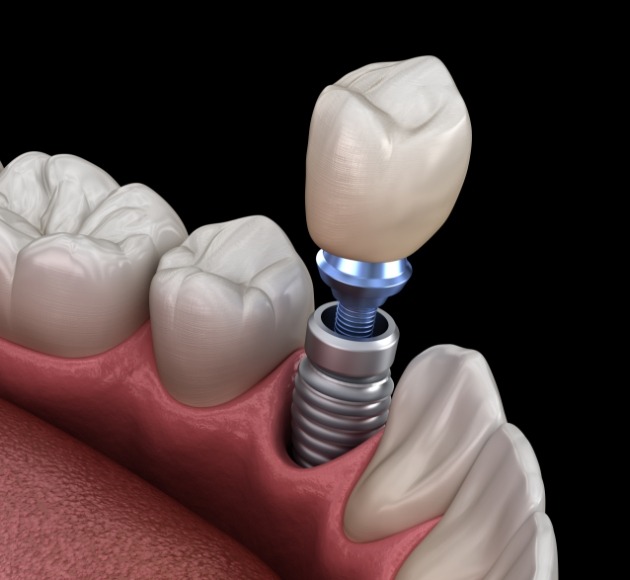
A dental implant is a post that, once placed in the jaw, is meant to mimic the function of a natural tooth root. These posts are made from biocompatible materials, often titanium or zirconia. After placement, they naturally begin to merge with the bone and surrounding tissues in a process known as osseointegration. This fusion is what allows dental implants to provide such a reliable and long-lasting replacement for any number of missing teeth. Once osseointegration is finished, we can secure an abutment on top that will support a lifelike dental crown, bridge, or denture. The end result of dental implant treatment is a tooth loss solution that looks and functions just like your lost pearly whites!
The 4 Step Dental Implant Process

Some dental offices don’t place dental implants and will instead refer you to a specialist. Not only is this inconvenient, but it also means the procedure will be performed by someone you’re not familiar with. By placing our dental implants in house, we help you avoid unnecessary travel time and ensure that you receive the treatment from a dentist in Natick that you know and trust. Thanks to the expertise of our in-house Board-Certified periodontist, Dr. Paola Buckley, your treatment will be safe, convenient, and comfortable. That being said, the dental implant process does take longer than the process of getting a denture or dental bridge; it may take several months to a year or longer. However, implants can potentially last a lifetime, so they’re definitely worth the wait! While each patient’s tooth replacement journey is slightly different, here are the four basic steps you can expect.
Initial Dental Implant Consultation
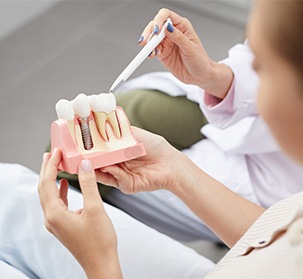
The first step on the path to a restored smile with dental implants is to schedule an initial consultation. During this first meeting, one of our experienced dentists will carefully examine your teeth and discuss your personal smile goals to determine if you are a good candidate for dental implants. If necessary, your dentist may recommend a preliminary treatment, such as a bone graft or sinus lift, to help ensure your treatment is successful. Finally, a personalized treatment plan will be developed that will map out the steps to your new, restored smile.
Dental Implant Surgery
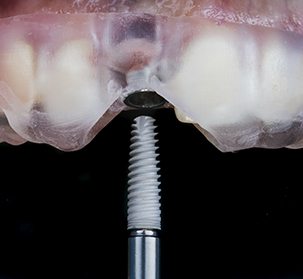
Placing dental implants typically involves a minimally invasive surgery. The word “surgery” can sound scary, but don’t worry! Local anesthesia or sedation dentistry will be utilized to ensure your complete comfort throughout the procedure. To place an implant, Dr. Buckley will make a small incision in your gums where your teeth are missing. Next, she will insert the dental implant post into the underlying jawbone. Once the implant is in the correct position, Dr. Buckley will close the gums back up with a few stiches. It’s that easy!
Dental Implant Osseointegration/Abutment
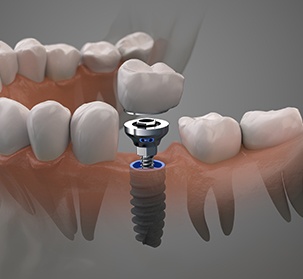
After implant placement, we will give you several months to heal. During this time, the biocompatible dental implant will fuse with the surrounding jawbone. This natural process, known as osseointegration, is what gives implants their maximum stability. Once the implant has fused with the bone, you will visit our dental office again so we can place an abutment. An abutment is an important connector piece that attaches a dental implant to an artificial tooth or dental prosthetic.
Delivery of Dental Implant Restorations
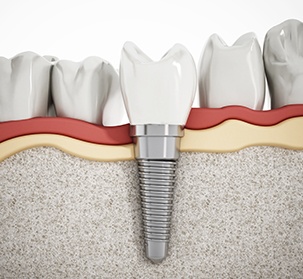
After your gums have healed around the abutment, you will be ready to receive your new crown, bridge, or denture. We will welcome you back to our dental office once more so your dentist can securely fasten your dental restoration to the implants. During this visit, your dentist also will be sure to check that your bite aligns properly and that you feel comfortable overall. Once this final step is complete, you will be ready to walk out of the dental office doors and begin enjoying life with your newly restored smile!
Benefits of Dental Implants

Tooth loss is a major concern for many of our patients at Papageorgiou Dental Associates, and we provide multiple options for replacements. However, dental implants are one of the most popular treatments, and it’s easy to see why! They’re versatile and offer several benefits that you can’t get with other tooth replacements like traditional dentures and bridges. If you’re curious to see how dental implants can benefit you, read more below.
Day-to-Day Benefits

The most obvious benefits of dental implants show themselves in your everyday routine. Whether you’re enjoying a quiet evening at home or going out with friends, dental implants are always with you, helping you in multiple ways, such as:
- Helping You Chew: Dental implants restore around 70 percent of your biting and chewing force. This allows you to continue eating all your favorite foods without worry.
- Restoring Your Speech: Missing teeth can make pronouncing certain syllables or words difficult. Dental implants restore these functions, preventing speech impediments.
- Improving Your Confidence: If you’re missing a tooth, it can be embarrassing and make you want to pull away from social situations. Dental implants complete your smile and help you feel more confident.
Health Benefits

Besides the obvious day-to-day benefits, dental implants can also improve your health and wellness in several ways. While you may not see these effects immediately, over time they’ll become more apparent.
- Stimulates Your Jawbone: A feature unique only to dental implants is their ability to keep your jawbone strong and healthy through chewing stimulation.
- Improves Your Digestion: Missing teeth can make chewing more difficult which leaves your food less prepared, wreaking havoc on your digestive system. Dental implants restore your body’s ability to process food properly.
- Reduces Oral Issues: With large gaps between your teeth, oral hygiene becomes more difficult, as your teeth shift, and your gums are exposed. A dental implant closes the gap and helps reduce oral hygiene problems overall.
Long-Term Benefits

Dental implants are a long-lasting treatment by design. Once the titanium fixture has fused with your jawbone, it becomes incredibly sturdy. They also have one of the highest success rates of any dental procedure at 95 percent or higher. This means that your implants will last for a long time! Here are some of the long-term benefits:
- Makes Replacements Easy: Once your dental implant has fused to your jawbone, you won’t need to have it replaced if you take proper care of it. Instead, you’ll simply replace the prosthetic on top every decade or so.
- Saves You Money: By providing multiple benefits, dental implants become a better investment of money the longer you have them. While the initial cost can seem like a lot, you won’t have to shell out every few years for costly replacements or extra oral care products.
- Improves Your Appearance: Since dental implants stop your jawbone from deteriorating over time, the structures that support your facial muscles and jaw will endure longer. This helps you stay looking youthful.
Who Dental Implants Can Help?

Implants can be used to replace any number of missing teeth, but the exact amount needed depends on what kind of dental restoration they’ll support. Depending on your needs, implants can support crowns, bridges or dentures.
Missing One Tooth
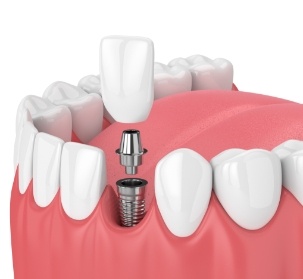
If there’s only one tooth missing, it can be replaced with a simple dental crown. Our dentists use porcelain crowns because their shading and the way they reflect the light are similar to that of natural teeth. The implant post will be below the gumline and hidden by the crown, so most people won’t realize you’ve had dental work done.
Missing Multiple Teeth
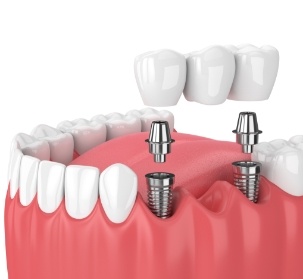
When two or more teeth in a row are gone, they can be replaced by a dental bridge that consists of multiple crowns. Traditional bridges are supported by natural teeth, but this means making alterations to the enamel; a bridge supported by implants will let you preserve more natural tooth structure.
Missing All Teeth
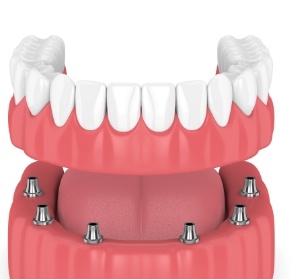
If all of the teeth on one of your jaws is missing, you’ll most likely require dentures in order to perform everyday tasks like chewing and speaking. Traditional dentures sit directly on the gum line; as bone loss progresses, they tend to become ill-fitting and more likely to slip. Dentures retained by several implants can help you avoid this problem.
Learn About Implant Retained Dentures
Maintaining & Caring for Your Dental Implants

Once you’ve received your dental implants, it now falls on you to protect your smile and ensure that your new teeth are able to serve you well for many years. Believe it or not, caring for dental implants is very similar to caring for natural teeth, and by keeping a few key things in mind, you won’t even notice a difference in your oral routine or how your smile feels. Continue reading to learn some useful tips to help you care for your dental implants and ensure that they’re able to do their job, or feel free to contact us if you have any questions!
Make Oral Hygiene a Priority

Even though your dental implants are replacing teeth that were lost, this doesn’t mean they replace the need for consistent oral hygiene—in fact, maintaining a healthy smile is arguably now more important than ever before! Fortunately, dental implants don’t require specialized care or specific products; you can simply brush and floss every day to keep your implants and the rest of your mouth problem-free.
Eat a Healthy Diet

Your diet and oral health are closely connected, no matter how many of your teeth you’ve had replaced with dental implants. A diet that contains high amounts of sugar and starches will only cause serious issues for your whole mouth, including your dental implants. This means that you’ll want to strive to maintain a healthy diet once you’ve undergone implant placement. Rather than opting to snack on candy, chips, or other unhealthy items, strive to add more fruits, vegetables, dairy products, lean proteins, and leafy greens into your diet. It’s also wise to eat items high in calcium and vitamin C, since they can directly benefit your bone health and dental implants.
Break Bad Habits

There are a lot of habits out there that might seem relatively harmless to your smile—however, the last thing you should want to do is unknowingly harm your dental implants or cause them to fail prematurely. Smoking (and using tobacco in general) is by far one of the worst habits you can partake in if you have dental implants; the habit can destroy the gum tissue supporting your implant posts, not to mention, increase your risk of oral cancer. You should also refrain from biting your nails, chewing on ice cubes, or using your teeth as tools to open packaging or hold objects; any habit that can cause issues for your natural teeth can similarly affect your dental implants.
Protect Your Dental Implants

It’s true that dental implants are remarkably durable, but you’ll still want to take certain measures to protect your mouth. For instance, if you regularly stay active by playing sports or outdoor games, you should consider wearing a mouthguard. These devices are designed to protect your teeth, and by proxy, your dental implants, from the physical trauma that may occur during these activities. Likewise, if you’re prone to grinding your teeth, a custom-made nightguard can usually prevent this harmful habit from causing wear on your dental restorations or harm to your jaw joints.
Schedule Regular Dental Checkups

One of the most important things to keep in mind once you’ve received your dental implants is that you’ll need to continue visiting us every six months for routine preventive care. These checkups are critically important; not only do they ensure that your remaining natural teeth, gum tissue, and other oral structures are in great shape, but they also let us inspect your implants and check for any concerning symptoms. Assuming you’re able to keep up with these visits, there’s a very high chance that your dental implants will serve you well for life!
Cost of Dental Implants

Before you actually get dental implants, you should learn their price. Doing so confirms whether they fit your budget or not. That said, note that the cost of dental implants varies. You’ll need to consult our dentists for a more exact estimate. Once you have, we’ll strive to make your treatment affordable. Our office will guide you through implants’ pricing factors, payment options, and more. For the details, please keep reading or call our office.
Preliminary Treatments & Dental Implant Surgery

Ahead of an implant surgery, you may require extra care. Perhaps your mouth needs a bone graft, gum disease therapy, or tooth extraction first. If so, your expenses will only increase. On the bright side, most dental plans do (somewhat) cover preliminary implant work.
Don’t forget that your implant surgery also incurs a price. Based on things like anesthesia and final implant location, treatment costs can rise or fall. Still, our office will perform the surgery fully in-office. You won’t have to pay extra to see an outside specialist.
The Parts of Your Dental Implant
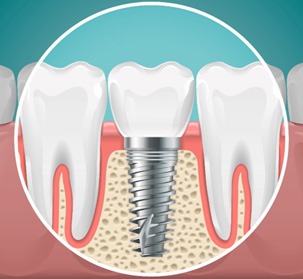
Of course, the traits of your implants also affect their price. These features can include:
- Implant Number – Your treatment price rises as a dentist places more implants. For instance, one implant post will cost less than 4-6 for an implant denture.
- Implant Size/Material – Dental implants can have different sizes and materials. Longer ones are more expensive, for example. Meanwhile, zirconia implants cost more than titanium kinds.
- Restoration Type – As it turns out, dental crowns, bridges, and dentures have distinct prices. The smaller your implant’s restoration, the less costly it’ll be.
- Implant Brand – Given an implant’s manufacturer or brand, it may cost more or less. Different implant providers will inevitably cater to varying needs.
How Dental Implants Can Save You Money
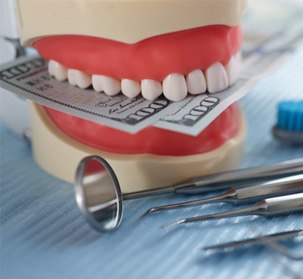
Yes, dentures and dental bridges can seem like the less costly options. Each of these devices has a lower upfront price than an implant. However, dental implants save their patients more money overall.
You see, dental implants can act as great long-term investments. Their ability to last long times (15-30 years or more) means they hardly ever need repairs. Plus, these posts don’t need “accessories” – adhesives, pastes, etc. – to work. Implants usually improve oral health as well. In other words, they’ll make you less likely to need costly care for mouth problems.
Does My Dental Insurance Cover Dental Implants?

Dental insurance seldom covers dental implants. In fact, the average plan views them as needless add-ons. Patients must thus pay out of pocket for them.
All that said, there are exceptions now and again. Your dental plan may well offer partial coverage. Therefore, try to review your policy’s benefits before treatment. Our office’s team members will happily help you do so.
Making Dental Implants Affordable

With or without insurance, dental implants can be affordable. Some great ways to make them budget-friendly are a dental practice’s payment options. Given the right kind, your future implants won’t break the bank.
For instance, consider our own Papageorgiou Dental Associates. Our office works with CareCredit – a reputable, 3rd party financier. They’d allow you to pay for dental implants in monthly installments. That way, you won’t have to meet the full treatment cost all at once.
In the end, our office want your implants to have the right function and cost. Learn more about financing them by attending a consultation at our office.
Dental Implant Post-Op Instructions

Now that you’ve had your new dental implants surgically placed, it’s time for the recovery process to begin. Thankfully, it’s nothing to worry about! Below, we’ll outline what you can expect, including which symptoms are normal and how you can help your smile heal. If you ever experience intense, abnormal pain or other strange side-effects that aren’t mentioned here, please don’t hesitate to contact Dr. Papageorgiou for help.
What to Do Directly After Dental Implant Surgery

Following your dental implant procedure, your biggest priority will be to leave the forming blood clots untouched so that your healing happens smoothly. To improve your odds of this occurring, make sure you follow these rules:
- Don’t spit. Use tissues or swallow saliva.
- Do not use drinking straws.
- Don’t smoke for at least the first day.
- Do your best to keep fingers/tongue away from the surgical site(s).
Common Side-Effects When Recovering from Dental Implant Placement

Some mild side-effects are perfectly normal, especially in the first few days after your dental implant placement. These may include:
- Intermittent bleeding, which can be minimized with gauze and by applying light pressure. This can occur for multiple days.
- Swelling over the first 72 hours which may last for over a week. Cold and warm compresses can help.
- General discomfort. If this occurs, you may take pain medication to alleviate it.
Each of these side effects should be temporary and will gradually subside with time. If this is not the case, please contact Dr. Papageorgiou as soon as possible.
Your Diet After Dental Implant Surgery

In the first few days after your dental implant surgery, we recommend eating a diet of softer, non-abrasive foods, including:
- Mashed potatoes
- Yogurt
- Ice cream
- Pudding
- Soup (not extremely hot)
- Scrambled eggs
- Pasta
You can return to eating a normal diet as soon as you feel up to it; however, we recommend limiting any overly crunchy or tough foods for a while and avoiding any direct chewing on the implant sites.
Post-Op Health & Oral Hygiene

The day after surgery, it’s okay to brush your teeth as usual, but be very careful near the surgical sites. Rinse your mouth two or three times a day (ideally after eating) with salt water. Use prescription mouthwash if you have it. Avoid any mouthwash that contains high levels of alcohol such as Listerine or Scope.
What to Do After Your New Teeth Are Attached
The great news is that the hardest part of your dental implant treatment is already behind you! When your new crown, bridge, or denture is attached to your dental implants, you may experience some minor, temporary sensitivity in the gum tissue. Thankfully, this is very easy to control with pain reliever. There shouldn’t be any swelling, bleeding, or extensive recovery. In fact, you should be ready to show off your new smile the very same day!
Dental Implant Frequently Asked Questions
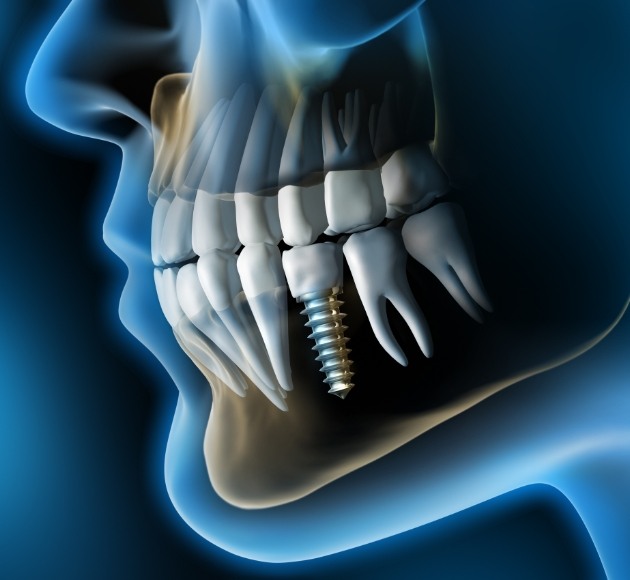
By now, you might be interested in getting dental implants to restore the health and appearance of your smile. However, you undoubtedly have some questions. To help you out, we have gathered some of the dental implant questions that we get asked the most often and answered them for your convenience.
I Smoke. Can I Still Get Dental Implants?
Yes, but there is a greater risk of implant failure. Smoking or chewing tobacco hinders the mouth’s ability to heal, which is critical when it comes to the success of your dental implants in Natick. Once implants are placed, your jawbone actually grows around them in a process called osseointegration. This process takes several months, and if your healing ability is constantly compromised by using tobacco, it drastically increases the risk that your body will reject the implant. If you have been looking for a reason to quit smoking, getting dental implants would be it.
I’m Diabetic. Can I Get Dental Implants?
Yes, but like with smoking, the risk of implant failure is higher. If you have diabetes, especially if the condition is poorly controlled, your body has a harder time fighting off infections. In addition, you could take longer to heal. This gives your jawbone more time to potentially develop an infection that could compromise the osseointegration process. If you’re considering dental implants, talk to your primary care physician or endocrinologist about how to better manage your diabetes first.
How Long Do Dental Implants Last?
Dental implants are designed to last at least 30 years, and may even last for the rest of your life if you take proper care of them. Implants are not susceptible to dental diseases like tooth decay, but the health of your gums is still critical to their long-term success. Use a soft-bristled toothbrush and dental floss to clean around your implant restoration every day, and see your dentist in Natick every six months for a professional cleaning and checkup to make sure your implant is still in good condition.
Does It Hurt to Get Dental Implants?
You will likely be under some form of sedation when you receive your implants. That, coupled with plenty of local anesthetic, means that you should feel minimal discomfort during the procedure. Afterwards, you can expect to feel some soreness, as with any type of surgery. Take over-the-counter pain relievers as recommended. We may also prescribe some prescription pain relievers, depending on your case. Just remember to only take the recommended dose.

